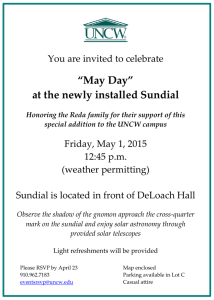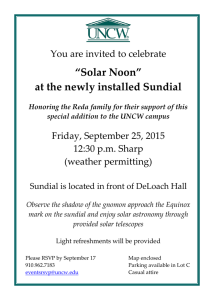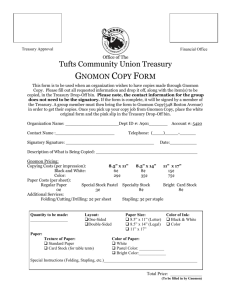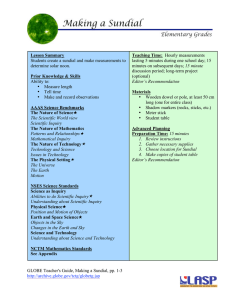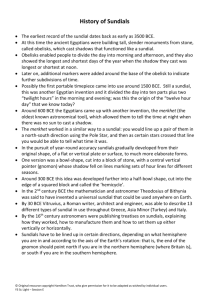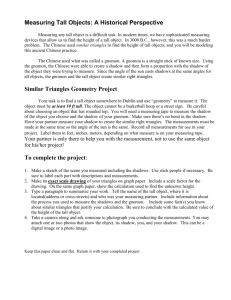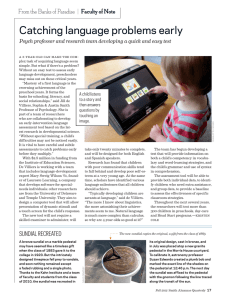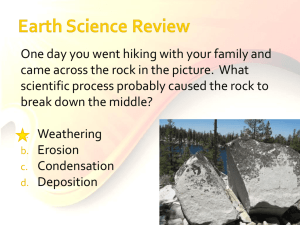Solar Matters I ... Human Gnomon
advertisement
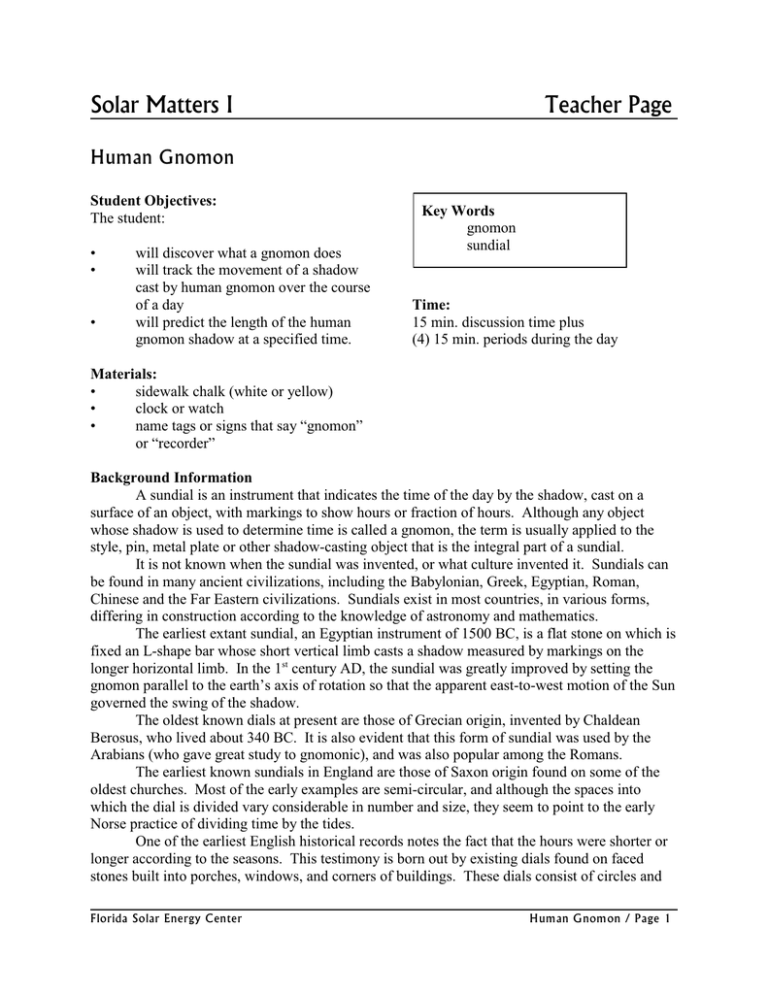
Solar Matters I Teacher Page Human Gnomon Student Objectives: The student: • • • will discover what a gnomon does will track the movement of a shadow cast by human gnomon over the course of a day will predict the length of the human gnomon shadow at a specified time. Key Words gnomon sundial Time: 15 min. discussion time plus (4) 15 min. periods during the day Materials: • sidewalk chalk (white or yellow) • clock or watch • name tags or signs that say “gnomon” or “recorder” Background Information A sundial is an instrument that indicates the time of the day by the shadow, cast on a surface of an object, with markings to show hours or fraction of hours. Although any object whose shadow is used to determine time is called a gnomon, the term is usually applied to the style, pin, metal plate or other shadow-casting object that is the integral part of a sundial. It is not known when the sundial was invented, or what culture invented it. Sundials can be found in many ancient civilizations, including the Babylonian, Greek, Egyptian, Roman, Chinese and the Far Eastern civilizations. Sundials exist in most countries, in various forms, differing in construction according to the knowledge of astronomy and mathematics. The earliest extant sundial, an Egyptian instrument of 1500 BC, is a flat stone on which is fixed an L-shape bar whose short vertical limb casts a shadow measured by markings on the longer horizontal limb. In the 1st century AD, the sundial was greatly improved by setting the gnomon parallel to the earth’s axis of rotation so that the apparent east-to-west motion of the Sun governed the swing of the shadow. The oldest known dials at present are those of Grecian origin, invented by Chaldean Berosus, who lived about 340 BC. It is also evident that this form of sundial was used by the Arabians (who gave great study to gnomonic), and was also popular among the Romans. The earliest known sundials in England are those of Saxon origin found on some of the oldest churches. Most of the early examples are semi-circular, and although the spaces into which the dial is divided vary considerable in number and size, they seem to point to the early Norse practice of dividing time by the tides. One of the earliest English historical records notes the fact that the hours were shorter or longer according to the seasons. This testimony is born out by existing dials found on faced stones built into porches, windows, and corners of buildings. These dials consist of circles and Florida Solar Energy Center Hum an Gnom on / Page 1 half-circles, divided by lines which radiate from a hole in the center to the circumference. The number of lines differ considerable and the spaces are also of unequal size. In later years the face of the dial was more divided, and moved from being quite plain in appearance to gradually taking a more ornate shape. Sundials continued to be placed into use long after clocks were available and in the 17th century many fine specimens were erected. Clocks did not in any way diminish the popularity of sundials, but rather the clocks helped to keep sundials in existence, as clocks stopped running and lost time, sundials were long employed for setting and checking clocks. Solar (apparent) time indicated by sundials and clock (mean) time is different and must be correlated by the use of tables which show the daily variation in sun time. A correction must also be made for the difference in longitude between the position of a sundial and the standard time meridian of a given locality. Sundials are still used in many areas, although they are regarded today as adornments usually found in gardens. However, sundials placed in gardens will not generally tell accurate time, except by coincidence. The largest sundial in the world was constructed in 1724 in Jaipur, India. This sundial covers almost one acre and has a gnomon over 100 ft high surmounted by an observatory. Procedure 1. Students should work in teams of two. 2. Give each pair of students one of the gnomon signs and one of the recorder signs. 3. Explain to the students that one of the students will be the gnomon and will wear that sign and the other student will be the recorder. 4. At this point it doesn’t matter if the students know what a gnomon is. Tell them that at the end of the day after they do their experiment, they will all talk about what they think a gnomon is. 5. Ask the students to go out to the black top and find a sunny location. Make sure there is enough space between students. 6. Pass out the chalk to each of the recorders and explain that the recorders will trace the feet of their gnomon partner and write their name inside the footprints. This will help them come back to the exact same spot throughout the day. 7. Then have the recorders trace around the edge of the shadow of their gnomon.(Remind the gnomons that they must stand very still with their arms by their sides.) Have them write the number ‘1' inside the shadow. 8. Throughout the day, have the teams return to their original spot. Make sure the gnomon places his/her feet inside the footprints already there before the recorder makes a second, third and fourth tracing. Each time have the students write the number inside the drawing. 9. Throughout the day, ask the students to predict where the next shadow will be. Ask them if the shadow will be shorter or longer, etc. Ask the students what they think a gnomon is and what it does. Have them draw a picture of what happened during their experiment. Key Words & Definitions • gnomon – The raised projection on a sundial which casts the shadow Florida Solar Energy Center Hum an Gnom on / Page 2 • sundial – A sundial consists of the dial plate marked out with hour lines, and a "gnomon", the raised projection that casts the shadow. The inclined edge of the gnomon, called the "style", produces the working edge of the shadow that is used to tell the time. The style is oriented parallel to the earth's axis, pointing toward Polaris, the pole star visible at night. Further Activities 1. Make a classroom sundial that is suitable for a garden installation. Line a springform pan with waxed paper. Pour plaster of paris (or concrete mix) into the pan. Sundials could be imprinted with objects (leaves, hands, etc) while still wet, or could have small objects (marbles, pieces of tile or stones) imbedded in them. Before the plaster is set, stick a wooden dowel, plastic rod or metal rod into the center for the gnomen. Support the gnomen in an upright position until the plaster dries. One way to do this would be to tape strips of cardboard or heavy paper bracing from the gnomen to the sides in several places. Sundials may be painted with sun markings when dry. Related Reading • Gregory’s Shadow by Don Freeman (Puffin Books, 2002) This ingenuous tale by the creator of Corduroy introduces another endearing animal character. Gregory Groundhog always feels braver when his best pal, his shadow, accompanies him. On the day before Groundhog Day, Gregory suggests that he and Shadow go find something to eat. "Sure... I'm right behind you," quips his amorphous companion, whom Gregory inadvertently leaves outdoors when he returns to his burrow. After the two are reunited, the groundhog faces another dilemma: He doesn't want to be separated from his friend again, yet he knows that his appearance with his shadow on the following morning will make the local farmers unhappy, since this augurs six more weeks of winter. Not surprisingly, Gregory devises a simple solution to this quandary that pleases all involved. • Guess Whose Shadow? by Stephen R. Swinburne ( Boyds Mills Press, 1999) This book takes a simple concept and creates an interesting, joyful, and challenging experience for young readers. Swinburne’s pictures remind them that shadows are of all shapes and sizes and appear everywhere. And everything has one, even inanimate objects. The foreword explains what makes shadows, and the following 30 full-color photographs convince children that they are beautiful, intriguing, and puzzling. The inclusion of a guessing game makes the book interactive. The pictures are full of life and action in this wonderful world of parades and swimming holes and waterfront walks. Florida Solar Energy Center Hum an Gnom on / Page 3 Solar Matters I Florida and National Standards Next Generation Science & Common Core Human Gnomon Florida NGSS Standards and Related Subject Common Core .1 .2 .3 .4 .5 X X X X X X X X .6 Grade K The Practice of Science Big Idea 1 SC.K.N.1 Earth in Space and Time Big Idea 5 SC.K.E.5 Big Idea 1 SC.1.N.1 X X The Practice of Science Big Idea 1 SC.2.N.1 X X Earth Systems and Patterns Big Idea 7 SC.2.E.7 X M athematics Standards Kindergarten: MAFS.K.MD.1.1, MAFS.K.MD.1.2 Grade 1 The Practice of Science Grade 2 Kindergarten Benchmarks Science--Big Idea 1: The Practice of Science • SC.K.N.1.1 - Collaborate with a partner to collect information. • SC.K.N.1.2 - Make observations of the natural world and know that they are descriptors collected using the five senses. • SC.K.N.1.3 - Keep records as appropriate -- such as pictorial records -- of investigations conducted. • SC.K.N.1.4 - Observe and create a visual representation of an object which includes its major features. • SC.K.N.1.5 - Recognize that learning can come from careful observation. Science--Big Idea 5: Earth in Space and Time • SC.K.E.5.2 - Recognize the repeating pattern of day and night. • SC.K.E.5.3 - Recognize that the Sun can only be seen in the daytime. Mathematics–Measurement & Data • MAFS.K.MD.1.1 - Describe measurable attributes of objects, such as length or weight. Describe several measurable attributes of a single object. • MAFS.K.MD.1.2 - Directly compare two objects with a measurable attribute in common, to see which object has ‘more of “/” less of’ the attribute, and describe the difference. First Grade Benchmarks Science–Big Idea 1: The Practice of Science Florida Solar Energy Center Hum an Gnom on / Page 4 • SC.1.N.1.1 - Raise questions about the natural world, investigate them in teams through free exploration, and generate appropriate explanations based on those explorations. • SC.1.N.1.2 - Using the five senses as tools, make careful observations, describe objects in terms of number, shape, texture, size, weight, color, and motion, and compare their observations with others. • SC.1.N.1.3 - Keep records as appropriate - such as pictorial and written records of investigations conducted. Second Grade Benchmarks Science–Big Idea 1: The Practice of Science • SC.2.N.1.1 - Raise questions about the natural world, investigate them in teams through free exploration and systematic observations, and generate appropriate explanations based on those explorations. • SC.2.N.1.2 - Compare the observations made by different groups using the same tools. Science–Big Idea 7: Earth Systems and Patterns • SC.2.E.7.1 - Compare and describe changing patterns in nature that repeat themselves, such as weather conditions including temperature and precipitation, day to day and season to season. National Next Generation Science Standards Kindergarten Standards Science–Energy • K-PS3-1 - Make observations to determine the effect of sunlight on Earth’s surface. Note: Related Common Core Mathematics Standards are listed in the Florida section above. First Grade Standards Science–Earth’s Place in the Universe • 1-ESS1-1 - Use observations of the sun, moon, and stars to describe patterns that can be predicted. • 1-ESS1-2 - Make observations at different times of year to relate the amount of daylight to the time of year. Florida Solar Energy Center Hum an Gnom on / Page 5
